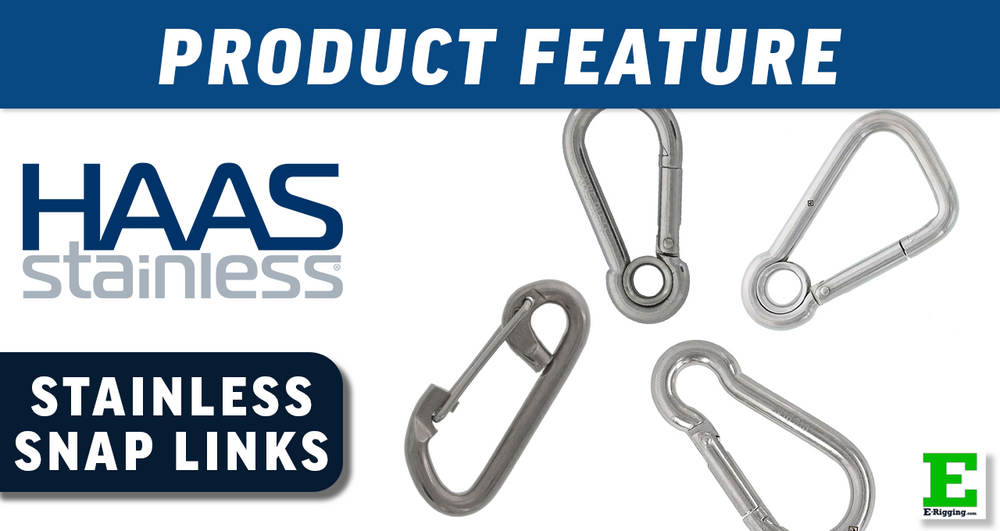Instructional Video on Snap Links
Snap Links FAQs
316 stainless steel has molybdenum added to its alloy content during production. Molybdenum provides an even higher degree of corrosion resistance than 304 stainless steel. This is an advantage for objects that require resistance to extreme environmental conditions such as salt water, de-icing salts, brine solutions, or other chemical forms of chemical exposure. In laboratory and pharmaceutical settings, 316 stainless steel excels in resistance to acids, bromides, and iodides at high temperature.
It is difficult to tell the difference between 304 and 316 stainless steel by simply looking at the two. They both offer the same polished, chromed, grained, colored, or blasted appearance but 316 stainless steel costs more due to its enhanced chemical and production properties. For more information on Stainless Steel see our stainless steel guide.
Snap links, such as those found in our stainless steel snap links collection, are versatile and durable connectors used in a variety of applications. Common uses include securing equipment in marine environments, connecting components in industrial settings, and ensuring safety in outdoor activities like climbing and camping. These quick release connectors are ideal for use cases where reliable and easy-to-use fasteners are required. Whether you need to secure a sailboat’s rigging, connect industrial tools, or set up a tent, snap links offer a dependable solution.
While snap links and carabiners may appear similar, they serve different purposes and have distinct designs. Snap links, often made from stainless steel or other corrosion-resistant materials, are typically used for lighter duty applications such as connecting chains, ropes, or straps in marine or industrial environments. In contrast, carabiners are designed for more demanding uses, such as climbing and rescue operations, where strength and safety are paramount. Carabiners usually have a locking mechanism to prevent accidental opening, making them suitable for critical safety applications. Our stainless steel snap links are perfect for general-purpose use, while specialized carabiners are recommended for high-stress activities.
Snap links can rust if they are made from materials susceptible to corrosion. However, our stainless steel snap links are specifically designed to resist rust and corrosion, making them ideal for marine and outdoor environments where exposure to moisture is common. The use of high-quality stainless steel ensures long-lasting performance and reliability, even in harsh conditions. This makes them perfect for applications such as boating, fishing, and any outdoor activities where equipment durability is crucial.
Snap links come in a variety of sizes to accommodate different applications and load requirements. At E-Rigging, we offer a wide range of snap link sizes, ensuring you can find the perfect fit for your specific needs. Whether you need small snap links for light-duty tasks or larger ones for more robust applications, we have the right size for you. Our detailed product listings provide all the necessary specifications, including dimensions and load capacities, to help you make an informed decision.
Yes, stainless steel snap links are ideal for use in marine environments. They offer superior corrosion resistance, which makes them perfect for withstanding the harsh conditions found at sea, such as exposure to saltwater, humidity, and extreme weather. These snap links are versatile and can be used for a variety of marine applications, including securing rigging lines, attaching sails, connecting anchor chains, and organizing gear on boats and yachts.
Snap links are categorized into three main ratings:
- Climbing and Fall Protection Rated: Designed specifically for safety in climbing and fall protection systems.
- Load Rated: Suitable for carrying specific loads but not for critical life-safety applications like climbing.
- Non-Load Rated: Often used for light-duty tasks such as key chains and other non-critical uses.
Load Rated Snap Links
At E-Rigging, our snap links are load rated, making them ideal for non-critical suspending applications. They are not rated for climbing or fall protection systems. Common uses include connecting chains for gates, animal harnesses, and various marine and fishing assemblies.For more information on our load-rated snap links and to find the right product for your needs, visit our snap links collection.
Recently viewed
- Opens in a new window.
































